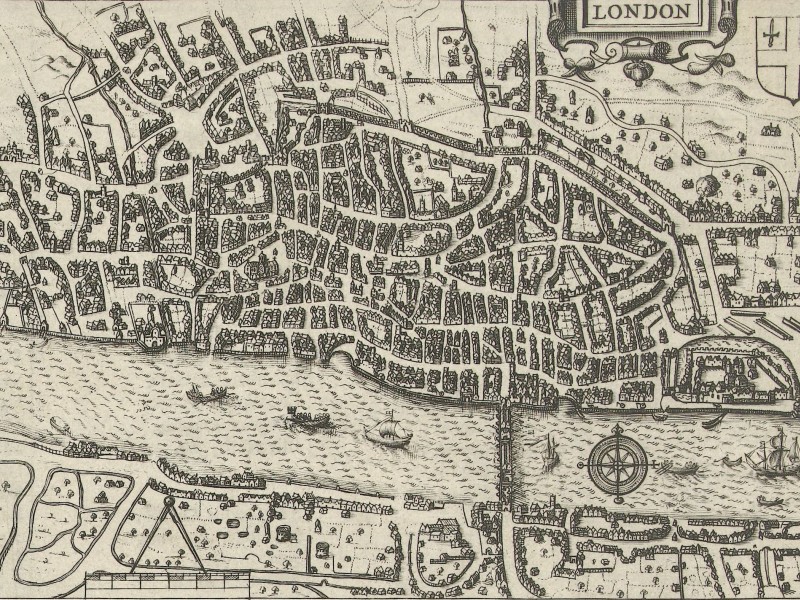
“Before I departed England, I heard news that Captain Draco had again taken much loot by capturing a ship from India on its way to Spain.”1
In London
12 September – 13 November 1585
Staying in London for two months was not what Samuel Kiechel had planned, but it was also not an enforced stay due to bad weather or a lack of transport. The traveller enjoyed his time in the city. He had found new companions, and they had made travel arrangements to Scotland and Ireland. However, not everything went as expected. Ultimately, Samuel Kiechel had to reconsider and decided to leave England to continue his journey on the continent.
Before we accompany him on his return trip to Hamburg, Samuel Kiechel concludes his report on his time in Elizabethan London with some general observations.
Executions in Elizabethan London
First, Samuel Kiechel witnessed a hanging. He noted that the individuals who carried out public executions, such as hangings, were not officially appointed hangmen, as would be the case back home in Germany. Instead, the English have a reprehensible custom. When a criminal is sentenced to death by hanging, the execution is not performed by a hangman. Instead, a butcher is tasked with carrying out the sentence. Our traveller remarked that he believed an honest man was often chosen for this job and would feel uncomfortable performing it, enduring much sorrow because all of this was done in public.
Kiechel then described how public executions took place: The criminal was placed on a cart and driven from the prison through London to the site of execution outside the city. The condemned remained on the cart, a rope was placed around his neck and tied to the crossbeam of the gallows. Then, the cart was moved away. Friends and family of the condemned would come and pull on his feet and legs to hasten his suffocation.
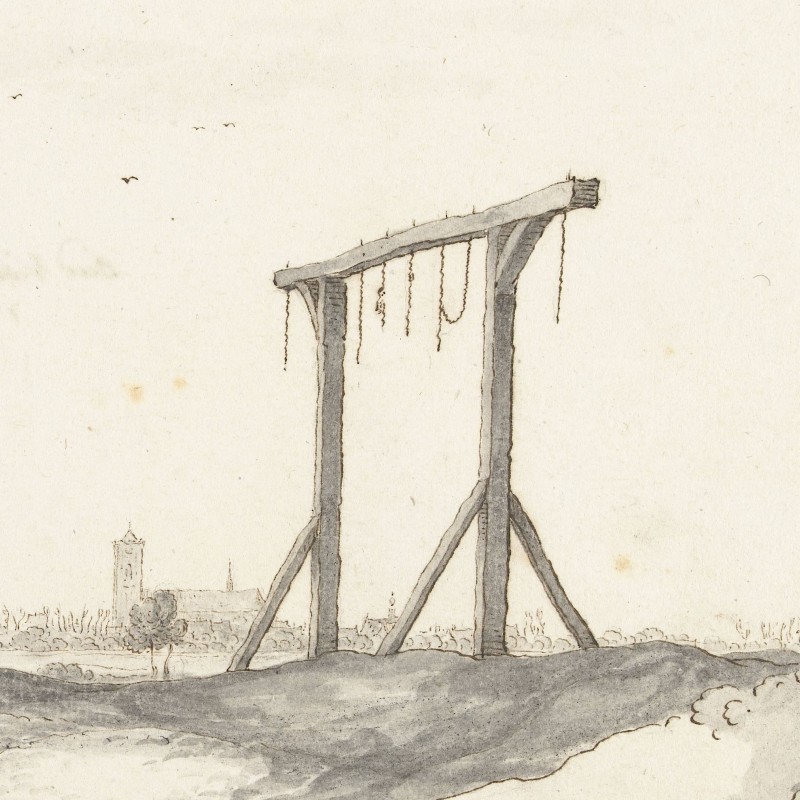
The site of public hangings was outside the city at Tyburn. However, some particularly violent offences were punished by erecting gallows as close to the crime scene as possible. As Kiechel wrote, the condemned was loaded onto a cart and driven from the prison through Newgate down Holborn to the gallows at Tyburn, three miles from the city. Hangings were public spectacles and a source of entertainment. The condemned could expect to find the road and the site of execution crowded with people eager to watch. Kiechel had been one of the spectators, as his description is quite accurate, down to the point where friends and family pull on the legs of the condemned to hasten their demise.2 However, I could not verify Kiechel’s observation that the hangmen were merely butchers ordered to carry out the executions.
News of Francis Drake
Following this sombre topic, Samuel Kiechel noted in his journal that he had heard news about the exploits of Captain Draco (Francis Drake). According to the reports, Drake captured a large ship en route from India to Spain. Here, India referred to the West Indies and America. Our traveller recounts what he had learned about the treasures discovered aboard the ship:
“2 million in gold and silver bullion,
50,000 Reichsthaler worth in minted Reals,
7,000 skins and pelts,
350 crates of sugar,
300 hundredweight of ginger,
150 hundredweight ivory,
4 crates of pearls,
many sacks of an excellent dye called conshenille”.3
Additionally, Drake had taken twenty-four Spaniards from noble families prisoner.
According to Kiechel, the ship had carried the tributes from the inhabitants of Peru for one and a half years, which they owed to the King of Spain. Our traveller heard that the tribute was estimated at twenty-five tons of gold.
Kiechel’s list includes ginger and ivory as part of the captured cargo. Neither item is native to South America. However, we must consider that our traveller had not seen the items and recorded what he had heard and what someone translated for him. Around the time Kiechel visited London, Francis Drake had just left Plymouth at the head of a fleet on an expedition to disrupt the Spanish colonies in America. The fleet captured Santiago in the Cape Verde Islands in November 1585. Yet, there are no reports of a large treasure ship being taken at that time. Given the substantial amount of loot our traveller mentioned, it seems that Samuel may have conflated a story about Francis Drake’s exploits during his circumnavigation five years earlier with a contemporary report.
Miscellaneous Observations
Finally, Samuel Kiechel made two observations about the inhabitants of the English capital. He remarked that the women of England are lovely and genuinely beautiful. He had never seen such women before. They do not wear makeup like those in Italy and other places. However, our traveller found their clothing to be somewhat graceless. While made from good linen and cloth, some women wore three petticoats layered on top of each other.
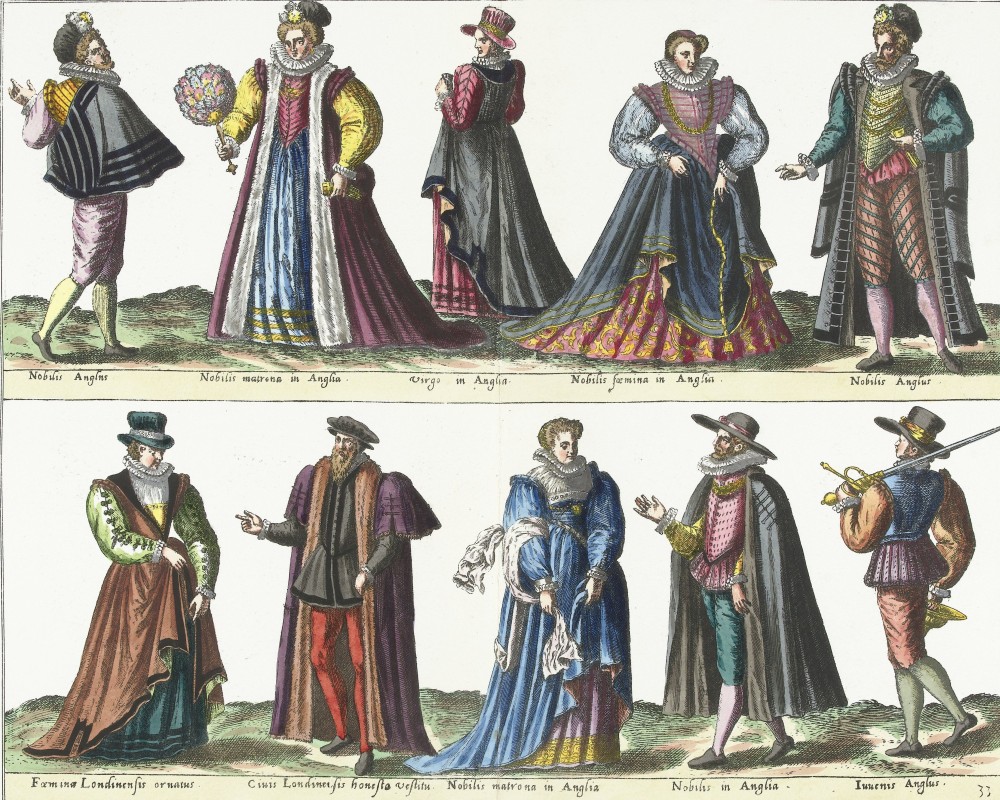
English fashion in a costume book dated 1581
We gain insight into how women in England dressed by examining costume books from the period. These books became popular in the late sixteenth century, featuring prints of individuals in their native attire from across Europe and beyond. The rise of costume books was linked to advances in cartography, similar to the “Civitates Orbis Terrarum”. Abraham Ortelius published the first modern atlas in 1570. Georg Braun and Frans Hogenberg, who published the “Civitates”, regarded their work as a supplement to Ortelius’s atlas. The creators of costume books saw their publications as another way to learn about the world — not its geography or towns, but its people.4
However, while costume books provide insight into how people dressed in the sixteenth century, the prints are not entirely representative. They suggest a uniform clothing style for individuals from different backgrounds (such as noblewomen, merchants, etc.) within a specific land, region, or city. However, no standard dress code conventions existed for these groups. Fashion styles and clothing items fluctuated, and individual differences were always present. The costumes depicted in the books primarily reflected the choices of the printmaker.5
Despite this, the images undeniably help illustrate how individuals in Samuel Kiechel’s time dressed. For this purpose, it is of little importance whether the costumes are idealised representations of the attire worn by different layers of society. Although the publishers of the costume books may have exercised creativity in their dress designs, their understanding and source material could only stem from the world around them — what they observed personally or in other publications.
The publishers of the “Civitates Orbis Terrarum” utilised costume books, incorporating depictions of people dressed in local fashion in their city views.
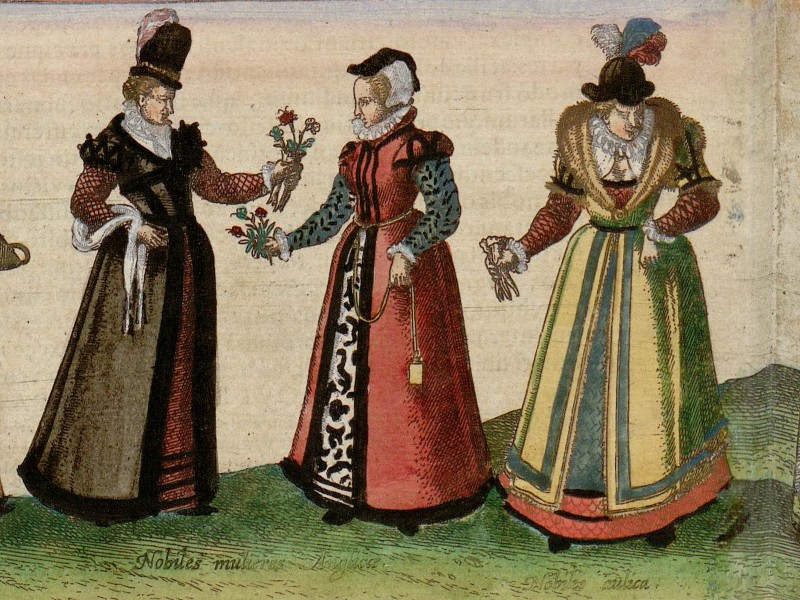
Costume Print of English Women in the “Civitates Orbis Terrarum”
Kiechel’s second observation noted that when a guest entered the house of a London citizen, whether for business or leisure, he was greeted by the man of the house. The women and maids of the household also welcomed him. Their custom involved embracing the women and kissing them. Should someone decline this custom, he was perceived as uncivilised and rude. According to Kiechel, this tradition was also observed in the Netherlands.
Foiled Travel Plans
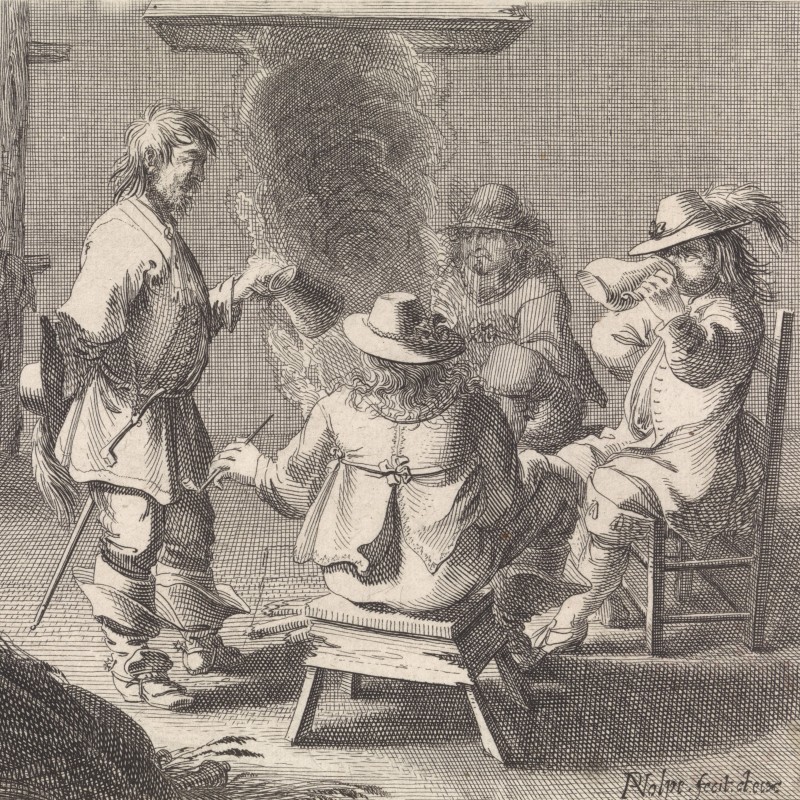
Samuel Kiechel spent his time in London in the company of ten German noblemen and other travellers he had met at the White Bear Inn. The group got along well, so they decided to journey together to the Kingdoms of Scotland and Ireland. They prepared for their trip by paying several gold coins for a royal passport. The passport listed the name of each traveller, and all bailiffs and reeves were ordered not to obstruct the group and, when necessary, to provide an escort. The travellers hired horses to carry them to the sea, as they intended to visit Ireland first.
Kiechel and his companions finished their preparations on a Saturday and planned to depart the following Monday. However, on Sunday, news arrived that the plague had spread to the Kingdom of Scotland and that all borders were closed. No one would be able to travel there. The King of Scotland (James VI, son of Mary Stuart) had left Edinburgh and retreated to a palace outside the city.
The news from Scotland was very distressing. Although the plague outbreak had already been reported a few days earlier, the lack of details suggested to the travellers that the situation was under control. Now, Kiechel and his companions were no longer inclined to continue their journey to Scotland. Our traveller remarks that he was sad not to undertake it, as he would have liked to see the trip go ahead, having now spent too much time in London for nought.
Leaving London
With the trip to Ireland and Scotland cancelled, our traveller was eager to leave England. He planned to travel to Antwerp but had heard that the route was considered dangerous due to the war in the Netherlands. Kiechel had to search for quite some time before he found a Dutchman from Antwerp whose parents still resided there. They agreed to travel together and eventually found another man from Antwerp, a messenger, to join them.
After two months in London, Samuel Kiechel left the city on 14 November aboard a large boat to Gravesend. The German travellers he had met in London and spent much time with accompanied him to the port in Billingsgate to see him off. On the boat were 200 passengers, and they arrived in Gravesend three hours later.
Illustrations & References
All images are in order of appearance with links to sources on external websites:
- Hondius, Jodocus, Midle-sex described with the most famous cities of London and Westminster, 1610; Rijksmuseum Amsterdam.
- Jordaens, L., Gezicht op de stad Naarden, 1640 – 1680; Rijksmuseum Amsterdam.
- Anonymous, Dubbele plaat met vijf mannen en vijf vrouwen gekleed volgens de Engelse mode, ca. 1580 (reprint of: Abraham de Bruyn, Omnium pene Europae, Asiae, Aphricae, Americae gentium habitus, 1581), 1872 – 1875; Rijksmuseum Amsterdam.
- Nonsuch Palace, in: Braun, Georg, Hogenberg, Frans, Civitates Orbis Terrarum (5), Cologne 1599, fol. 1v; Heidelberg University.
- Nolpe, Pieter, Mannen rond een vuur, 1623 – 1653; Rijksmuseum Amsterdam.
- Die Reisen des Samuel Kiechel aus drei Handschriften, K. D. Haszler (ed.), Stuttgart 1866, p. 30; Bayerische Staatsbibliothek. ↩︎
- Mortimer, Ian, The Time Traveller’s Guide to Elizabethan England, London2021, pp. 302f. ↩︎
- Kiechel, Reisen, p. 30; Cochineal is an insect used in the production of the dye carmine. A hundredweight is about fifty kilograms. ↩︎
- Ilg, Ulrike, The Cultural Significance of Costume Books in Sixteenth-Century Europe, in: Richardson, Catherine (ed.), Clothing Culture, 1350-1650, London, New York 2016, pp. 29-47, here p. 35f. ↩︎
- Ibid., p. 43. ↩︎